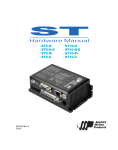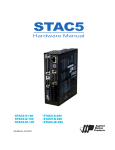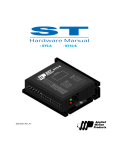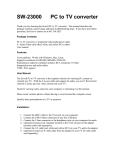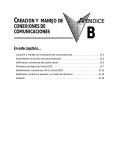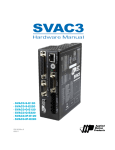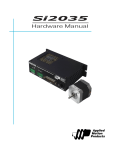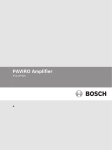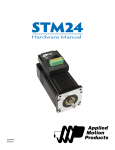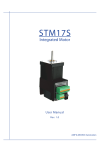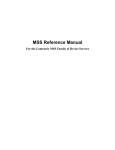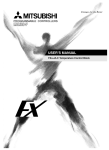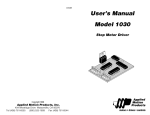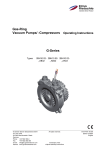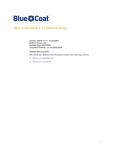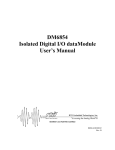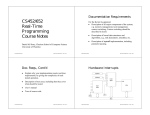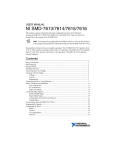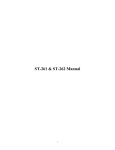Download STAC6_Hardware_Manual_920 0029
Transcript
STAC6 • STAC6-S • STAC6-Q • STAC6-QE • STAC6-Si • STAC6-C 920-0029 Rev. C 5/2/2012 • STAC6-S-220 • STAC6-Q-220 • STAC6-QE-220 • STAC6-Si-220 • STAC6-C-220 920-0029 Rev. C 5/2/2012 STAC6 Hardware manual Contents Safety Instructions............................................................................................................................4 Over-Current Protection....................................................................................................................5 Block Diagrams ................................................................................................................................6 Motion Control Options....................................................................................................................9 Getting Started................................................................................................................................10 Connecting to the PC using RS-232...............................................................................................11 Connecting to the PC using RS-485...............................................................................................12 Connecting to the CANopen Network..............................................................................................15 Connecting AC Power.....................................................................................................................17 Connecting the Motor.....................................................................................................................18 Connecting Other Motors................................................................................................................20 Connecting an Encoder ..................................................................................................................22 Wiring Inputs and Outputs..............................................................................................................24 Connecting Digital Inputs on the IN/OUT1 connector.....................................................................25 Connecting Digital Outputs on the IN/OUT1 connector...................................................................33 Connecting Analog Inputs on the IN/OUT1 connector.....................................................................35 Connecting Inputs and Outputs to IN/OUT2....................................................................................37 Connecting Digital Inputs on the IN/OUT2 connector.....................................................................37 Connecting Digital Outputs on the IN/OUT2 connector...................................................................42 Connecting Analog Inputs on the IN/OUT2 connector.....................................................................44 Recommended Motors....................................................................................................................45 Motor Dimensions..........................................................................................................................46 Torque-Speed Curves.....................................................................................................................49 Mounting the Drive.........................................................................................................................52 Mechanical Outline.........................................................................................................................53 Technical Specifications..................................................................................................................54 Mating Connectors and Accessories...............................................................................................56 Alarm Codes...................................................................................................................................57 2 920-0029 Rev. C 5/2/2012 STAC6 Hardware manual (This page intentionally left blank) 3 920-0029 Rev. C 5/2/2012 STAC6 Hardware manual Safety Instructions Only qualified personnel are permitted to transport, assemble, commission, and maintain this equipment. Properly qualified personnel are persons who are familiar with the transport, assembly, installation, commissioning and operation of motors, and who have the appropriate qualifications for their jobs. The qualified personnel must know and observe the following standards and regulations: IEC 364 resp. CENELEC HD 384 or DIN VDE 0100 IEC report 664 or DIN VDE 0110 National regulations for safety and accident prevention or VBG 4 To minimize the risk of potential safety problems, you should follow all applicable local and national codes that regulate the installation and operation of your equipment. These codes vary from area to area and it is your responsibility to determine which codes should be followed, and to verify that the equipment, installation, and operation are in compliance with the latest revision of these codes. Equipment damage or serious injury to personnel can result from the failure to follow all applicable codes and standards. We do not guarantee the products described in this publication are suitable for your particular application, nor do we assume any responsibility for your product design, installation, or operation. • Read all available documentation before assembly and commissioning. Incorrect handling of products in this manual can result in injury and damage to persons and machinery. Strictly adhere to the technical information on the installation requirements. • It is vital to ensure that all system components are connected to earth ground. Electrical safety is impossible without a low-resistance earth connection. • The STAC6 contains electrostatically sensitive components that can be damaged by incorrect handling. Discharge yourself before touching the product. Avoid contact with high insulating materials (artificial fabrics, plastic film, etc.). Place the product on a conductive surface. • During operation keep all covers and cabinet doors shut. Otherwise, there are deadly hazards that could possibility cause severe damage to health or the product. • In operation, depending on the degree of enclosure protection, the product can have bare components that are live or have hot surfaces. Control and power cables can carry a high voltage even when the motor is not rotating. 4 920-0029 Rev. C 5/2/2012 STAC6 Hardware manual • Never pull out or plug in the product while the system is live. There is a danger of electric arcing and danger to persons and contacts. • After powering down the product, wait at least ten minutes before touching live sections of the equipment or undoing connections (e.g., contacts, screwed connections). Capacitors can store dangerous voltages for long periods of time after power has been switched off. To be safe, measure the contact points with a meter before touching. Be alert to the potential for personal injury. Follow the recommended precautions and safe operating practices. Safety notices in this manual provide important information. Read and be familiar with these instructions before attempting installation, operation, or maintenance. The purpose of this section is to alert users to possible safety hazards associated with this equipment and the precautions that need to be taken to reduce the risk of personal injury and damage to the equipment. Failure to observe these precautions could result in serious bodily injury, damage to the equipment ,or operational difficulty. Over-Current Protection The STAC6 has hardware over-current detection circuits that protect the drive against “phase to ground” and “phase to phase” motor shorts. These circuits directly disable the amplifier in a rapid fashion to prevent damage to the driver circuitry. Typically, the over-current circuitry will react to an over-current condition in 3 to 5 micro-seconds. For a short occurring in a motor, the motor leads provide enough resistance and inductance to keep the peak current from exceeding the peak rating of the power transistors during this time period. The recommended motors for the STAC6 all include 10 foot cables. In essence the motor/cable system is a part of the over-current circuitry. If the drive is directly shorted with a very short wire, this condition may cause current conditions that exceed the peak current rating of our power transistors and therefore could weaken or cause failure in the drive power devices. Repetitive short circuits also risk damage to the drive. If a short circuit fault occurs, please power off the drive and investigate carefully before restoring power. 5 920-0029 Rev. C 5/2/2012 STAC6 Hardware manual Block Diagrams Block Diagram - STAC6-Si, STAC6-Si-220 DC Power Supply 120 VAC* 160 VDC** Regeneration Clamp Circuit X1/STEP X2/DIR X3/ENABLE X4/ALMRST X5 X6/CCWLIM X7/CWLIM Y1/FAULT Y2/MOTION Y3/BRAKE Internal Logic Supply Status MOSFET PWM Power Amplifier Optical Isolation Digital Signal Processor Interface ANALOG IN PC/MMI RS485/422 RS232 RS485/422 Si™ Programmable Controller *220 VAC for STAC6-220 **320 VDC for STAC6-220 eeprom ANALOG IN 6 Optical Isolation motor encoder INPUT1 INPUT2 INPUT3 INPUT4 INPUT5 INPUT6 INPUT7 INPUT8 OUT1 OUT2 OUT3 OUT4 920-0029 Rev. C 5/2/2012 STAC6 Hardware manual Block Diagram - STAC6-S, STAC6-Q, STAC6-QE, STAC6-S-220, STAC6-Q-220, STAC6QE-220 DC Power Supply 120 VAC* 160 VDC** Regeneration Clamp Circuit X1/STEP X2/DIR X3/ENABLE X4/ALMRST X5 X6/CCWLIM X7/CWLIM Y1/FAULT Y2/MOTION Y3/BRAKE Internal Logic Supply Status MOSFET PWM Power Amplifier Optical Isolation Digital Signal Processor Interface ANALOG IN PC/MMI RS485/422 RS232 RS485/422 Optical Isolation *220 VAC for STAC6-220 **320 VDC for STAC6-220 ANALOG IN -QE ONLY 7 motor encoder INPUT1 INPUT2 INPUT3 INPUT4 INPUT5 INPUT6 INPUT7 INPUT8 OUT1 OUT2 OUT3 OUT4 920-0029 Rev. C 5/2/2012 STAC6 Hardware manual Block Diagram - STAC6-C and STAC6-C-220 DC Power Supply 120 VAC* 160 VDC** Regeneration Clamp Circuit X1/STEP X2/DIR X3/ENABLE X4/ALMRST X5 X6/CCWLIM X7/CWLIM Y1/FAULT Y2/MOTION Y3/BRAKE Internal Logic Supply Optical Isolation Digital Signal Processor ANALOG IN PC (for Setup Only) CAN2.0b RS232 CANopen *220 VAC for STAC6-220 **320 VDC for STAC6-220 8 Status MOSFET PWM Power Amplifier Interface motor encoder 920-0029 Rev. C 5/2/2012 STAC6 Hardware manual Motion Control Options STAC6-S Control Options Basic drive: Analog, digital and host command input. • Pulse & Direction, A/B Quadrature, CW/CCW Pulse. • Velocity (Oscillator) Mode. • Host command execution of SCL commands for control from a host PC or PLC using RS-232 or RS485 serial communication. • Compatible with SiNet Hub 8 and SiNet Hub 444 for multi-axis Si programming. STAC6-Q, STAC6-QE Control Options Programmable drive: Built-in Q controller. • Comprehensive single-axis programming language. • Powerful feature set. • Complex motion and machine control. • Math functions. • Register manipulation. • Multi-tasking. • Host interrogation/interface while executing internal programs. • STAC6-QE comes with expanded I/O. STAC6-Si Control Options Programmable Drive: Built-in Si indexer. • Easy-to-use Si Programmer™ software. • Graphical point-and-click format combines motion, I/O, and operator interface. • Stand-alone operation. • Integrated Configurator for motor setup, encoder setup, and alarm history. • Easily integrates with other devices such as sensors, PLCs, etc. • Software and programming cable included. STAC6-C Control Options CANopen Node. • Compliant to CANopen standards DS301 • Supports the following DSP402 operating modes: • Profile Position Mode • Profile Velocity Mode • Homing Mode • Additionally, supports stand-alone Q Programming with CANopen execution 9 920-0029 Rev. C 5/2/2012 STAC6 Hardware manual Getting Started This manual describes the use of STAC6 series of step motor drives. What you need to know and what you must have depends on the drive model. For all models, you’ll need the following: • • • • • 120VAC or 220VAC single phase power. A compatible step motor (see recommended motors section) A small flat blade screwdriver for tightening the connectors (included). A personal computer running Microsoft Windows 98, 2000, NT, Me, XP or Vista or 7. The Applied Motion CD (included) If you’ve never used a STAC6 drive before you’ll need to get familiar with the drive and the set up software before you try to deploy the system in your application. We strongly recommend the following: 1. For -S drives, install the STAC Configurator™ software application from the CD. For -Q and QE drives, install the STAC Configurator™ and Q Programmer™ software applications from the CD. For -Si drives, install and use the Si Programmer™ software for configuration and programming. For -C drives, install the STAC Configurator™ and the CANopen Example Program software applications from the CD. Q Programmer™ software may also be installed, if needed. 2. Launch the software by clicking Start...Programs...Applied Motion... 3. Connect the drive to your PC with the programming cable. 4. Connect the drive to the motor. 5. Connect the drive to the AC power. 6. Apply power to the drive. 10 STAC6 Hardware manual 920-0029 Rev. C 5/2/2012 Connecting to the PC using RS-232 • Locate your computer within 8 feet of the drive. • Your drive was shipped with a communication cable. Plug the large end into the serial port of your PC and the small end into the PC/MMI jack on your drive. Secure the cable to the PC with the screws on the sides. CAUTION 1. Never connect a drive to a telephone circuit. It uses the same connectors and cords as telephones and modems, but the voltages are not compatible. 2. Drive ground and PC ground should be at the same potential. Different ground potentials for the drive and PC can result in excessive current through the ground pin of the RS-232 port, resulting in failure of the port. If your PC does not have a serial port, you should purchase a USB-serial converter to convert one of your PC’s USB ports into an RS-232 (COM) port. For 32-bit Windows operating systems, we have had good results with the Port Authority “USB Serial DB9” Adapter from CablesToGo.com and with the SW1301 from SewellDirect.com. Some laptops also have a PCMCIA slot, in which case the SSP-100 from Sewell Direct is a good choice. For 64-bit Windows operating systems, namely Windows Vista 64 and Windows 7 64, the Prolific-based adapters listed above do not work. For these PCs we suggest the USB-COMi-M or USB-CBL from Byterunner.com. These adapters also work the 32-bit operating systems. For USB choices, refer to page 52. ground (to PC ground) TX (to PC RX) RX (to PC TX) No connection Pin Assignments of the PC/MMI Port (RJ11 connector) 11 920-0029 Rev. C 5/2/2012 STAC6 Hardware manual Connecting to the PC using RS-485 Pin diagram is shown to the right. Wiring diagrams can be found on this and the next page. We recommend the use of Category 5 cable. It is widely used for computer networks, it is inexpensive, easy to get and certified for quality and data integrity. RS-485/422 RS-485 allows you to connect more than one drive to a single host PC, PLC, HMI or other computer. It also allows the communication cable to be long (more than 1000 feet). But the device to which you connect must have an RS-422 or RS-485 port. GND TX– TX+ RX– RX+ The STAC6 drives can be used with either two wire or four wire RS-485 implementations. The connection can be point to point (i.e. one drive and one host) or a multi-drop network (one host and up to 32 drives). Four wire systems utilize separate transmit and receive wires. One pair of wires must connect the host computer’s transmit signals to each drive’s RX+ and RX- terminals. Another pair connects the TX+ and TXdrive terminals to the host computer’s receive signals. A logic ground terminal is provided on each drive and can be used to keep all drives at the same ground potential. This terminal connects internally to the DC power supply return (V-), so if all the drives on the RS-485 network are powered from the same supply it is not necessary to connect the logic grounds. You should still connect one drive’s GND terminal to the host computer ground. Four wire systems are better than two wire types because the host can send and receive data at the same time, increasing system throughput. Furthermore, the host never needs to disable its transmitter, which simplifies your software. We recommend that a 120 ohm terminating resistor be connected between RX+ and RX- at the farthest drive from the host. to PC GND to PC RXto PC RX+ to PC TX120 to PC TX+ +RX- +TX- GND Drive #1 +RX- +TX- GND Drive #2 +RX- +TX- GND Drive #3 Two wire systems transmit and receive on the same pair of wires. The host must not only disable its transmitter before it can receive data, it must do so quickly, before a drive begins to answer a query. The 12 920-0029 Rev. C 5/2/2012 STAC6 Hardware manual STAC6 drives include a “transmit delay” parameter that can be adjusted to compensate for a host that is slow to disable its transmitter. This adjustment can be made over the network using the TD command, or it can be set using the STAC Configurator™ software. It is not necessary to set the transmit delay in a four wire system. We recommend a 120 ohm terminating resistor be connected between the two transmit / receive wires at the farthest drive from the host. to PC GND to PC TX- (A) 120 to PC TX+ (B) +RX- +TX- GND Drive #1 +RX- +TX- GND Drive #2 +RX- +TX- GND Drive #3 RS-232 to RS-485 2-wire Converter Model 485-25E from Integrity Instruments (800-450-2001) works well for converting your PC’s RS-232 port to RS-485. It comes with everything you need. Connect the adaptor’s “B” pin to the drive’s TX+ and RX+ terminals. Connect “A” to the drive’s TX- and RX- terminals. Converting USB to RS-485 The USB-COMi-M from www.byterunner.com is an excellent choice for USB to RS-485 conversion. It can be used with 2 wire or 4 wire systems. For two wire RS-485, set SW1 to ON and SW2-4 to OFF. On the USB-COMi-M screw terminal connector: Pin1 goes to RX- and TX-. Connect pin 2 to RX+ and TX+. Pin 6 is ground. The DB-9 is not used. For four wire RS-485, set SW1,3,4 to ON and SW2 to OFF. On the USB-COMi-M screw terminal connector: USB-COMi-MSTAC6 Drive pin 1 RX- pin 2 RX+ pin 3 TX+ pin 4 TXpin 6 GND 13 920-0029 Rev. C 5/2/2012 STAC6 Hardware manual USB-COMi-M Switch Settings 4 Wire RS-485 RS-232 ON 1 2 3 4 ON 1 2 3 4 2 Wire RS-485 ON 1 2 3 4 Note: Prolific-based USB serial adapters do not work with Vista 64 or Windows 7 64 bit operating systems. Suggested adapters are Byterunner USB-COMi-M or Byterunner USB-COM-CBL. Assigning Addresses in Multi-axis Systems Before wiring the entire system, you’ll need to connect each drive individually to the host computer so that a unique address can be assigned to each drive. Use the programming cable and the STAC Configurator™ software that came with your drive for this purpose. Connect the drive to your PC, then launch STAC Configurator™. Finally, apply power to your drive. If you have already configured your drive, then you should click the Upload button so that the STAC Configurator™ settings match those of your drive. Click on the Motion button, then select the “SCL” operating mode. If you have a Q drive, you may want to select “Q Programming”. Either way, you’ll see the RS-485 Address panel appear. Just click on the address character of your choice. You can use the numerals 0..9 or the special characters ! “ # $ % & ‘ ( ) * + , - . / : ; < = > ? @ . Just make sure that each drive on your network has a unique address. If you are using a 2 wire network, you may need to set the Transmit Delay, too. 10 milliseconds works on the adapters we’ve tried. Once you’ve made your choices, click Download to save the settings to your drive. 14 STAC6 Hardware manual 920-0029 Rev. C 5/2/2012 Connecting to the CANopen Network GND CAN_L SHLD CAN_H CANopen Connector The CANopen connector is a 4-pin spring lock type connector. The CANopen network should be connected in a daisy-chain fashion, with a 120 ohm terminating resistor at each end of the network. Please see the CANopen manual for more information. Node ID Switch Each node on a CANopen network must have a unique Node ID. On the STAC6, this is set using both the Configurator software (above, left), as well as the sixteen position hardware switch on the front of the drive (above, right). CANopen Node IDs are seven bits long, with a range of 1 - 127, or 0x01 - 0x7F in hexadecimal notation. The lower four bits, 0x0-0xF are set using the hardware switch, and the upper three bits, 0x0 - 0x7, are set using Configurator. A Node ID of 0x39, for example, may be set by turning the switch on the drive to 9, and setting the Configurator software to a range of 0x30 - 0x3F. 15 920-0029 Rev. C 5/2/2012 STAC6 Hardware manual Bit Rate Switch The CANopen network bitrate is set by the rotary switch on the front of the drive. The bitrate must be the same for all nodes on the CANopen network. The table below shows the various bitrates supported by Applied Motion Products, and their corresponding switch settings. Please note, any changes to the bitrate require either a powercycle or a CANopen reset command to take effect. Octal Switch Setting Resultant Bit Rate 0 1 Mbps 1 800 kbps 2 500 kbps 3 250 kbps 4 125 kbps 5 50 kbps 6 20 kbps 7 12.5 kbps 16 920-0029 Rev. C 5/2/2012 STAC6 Hardware manual Connecting AC Power Using the connector supplied connect to the AC supply per the diagram below. Use 16 AWG wire for Line (L) and Neutral (N). Use 14 AWG for Earth Ground (G). Care should always be taken when working with high voltages. In regions where the single-phase supply is higher, an auto transformer can be used to drop the voltage to the correct level. Fusing The STAC6 contains an internal 8A fast acting fuse. The STAC6-220 contains an internal 3.5A slo-blo (time delay) fuse. If an external fuse is desired, we recommend a 6A fast acting fuse for the 120V STAC6 and a 5 amp fast acting fuse for the 220V version. Line Filter For applications requiring CE EMC compliance, a Corcom 6ET1 line filter is required in series with the AC input. green eo whit r blue or black brow AC Power Plug 17 To Earth Ground n To Neutral To Line (Hot) 920-0029 Rev. C 5/2/2012 STAC6 Hardware manual Connecting the Motor Never connect or disconnect the motor while the power is on. Note: it is highly recommended that you use a motor with a shielded cable with the STAC6. The recommended Applied Motion motors for the STAC6 include shielded cables. See the Recommended Motors section for a list of part numbers. Note: If you need a rear shaft on the motor, for an encoder or otherwise, make sure to add a “D” to the part number. Example: HT23-550D. If your motor does not already have a connector attached or if you need to change the length of the cable, please follow the illustrations below. Be sure to connect the cable shield for safety and to minimize electrical interference. Motors recommended for the STAC6-220 drives can also be used with 120V drives if they are wired in a parallel configuration. See the diagram for parallel winding. Series connection • Use with all STAC6-220 drives and the following motors: • HT23-552, HT23-553, HT23-554 • HT34-495, HT34-496, HT34-497 • Use with STAC6 (120) drives and the following motors: • HT23-548, HT23-549, HT23-550 • HT34-488, HT34-489, HT34-490 YELLOW BLUE ORANGE BROWN WHITE GREEN RED BLACK SHIELD A+ White A+ Brown A+ A B+ B SHLD A– Brown 8 lead motor Orange SHLD Orange A– Green Red Yellow B+ Blue White Gree Black B– Series Connected 8L 18 920-0029 Rev. C 5/2/2012 STAC6 Hardware manual Parallel connection • Do not use parallel connection with STAC6-220 drives. • Use with STAC6 (120) drives and the following motors: • HT23-552, HT23-553, HT23-554 • HT34-495, HT34-496, HT34-497 A+ A– White A+ YELLOW Orange BLUE Brown ORANGE BROWN Brown Green 8 lead motor White 8 lead motor SHLD WHITE Black Red GREEN Yellow Blue RED B+ B– BLACK Series Connected SHIELD 19 Orange A– A+ A B+ B SHLD SHLD Green Red Blue B+ Yellow Black B– 8 Leads Parallel Connected 920-0029 Rev. C 5/2/2012 STAC6 Hardware manual Connecting Other Motors We can’t stress enough the wisdom in using one of the recommended motors. We’re not just trying to make money here, we want your application to be successful and the odds of that are highest when you have a high quality motor whose torque, rotor inertia and harmonic waveform content are precisely known. Furthermore, our motors include shielded cables to reduce electrical emissions and enhance safety and come with pre wired mating connectors which further reduces the risk of error. If you do want to connect other motors , here is some information that will help Four lead motors can only be connected one way. Please follow the sketch below. A+ A– Red 4 lead motor Blue White Yellow B+ B– 4 Leads Six lead motors can be connected in series or center tap. In series mode, motors produce more torque at low speeds, but cannot run as fast as in the center tap configuration. In series operation, the motor should be operated at 30% less than the rated current to prevent overheating. Winding diagrams for both connection methods are shown below. NC means not connected. A– NC A+ Grn/Wht Grn/Wht A– 6 lead motor White Green A+ NC Red Black B– NC Red/ Wht Green Red B– B+ 6 Leads Series Connected 6 lead motor White Black B+ Red/ Wht NC 6 Leads Center Tap Connected 20 920-0029 Rev. C 5/2/2012 STAC6 Hardware manual Eight lead motors can also be connected in two ways: series and parallel. As with six lead motors, series operation gives you less torque at high speeds, but may result in lower motor losses and less heating. In series operation, the motor should be operated at 30% less than the unipolar rated current. The wiring diagrams for eight lead motors are shown below. A+ Orange 8 lead motor Org/Wht Blk/Wht A– A+ Black Red B+ Red/ Wht Yellow Yel/ Wht B– 8 Leads Series Connected Orange Blk/Wht Org/ Wht A– 8 lead motor Black Red Yel/ B+ Wht Yel low Red/Wht 8 Leads Parallel Connected 21 B– 920-0029 Rev. C 5/2/2012 STAC6 Hardware manual Connecting an Encoder The motors recommended for use with STAC6 drives are available with rear-shaft mounted encoders. Note: remember to always order a double-shaft motor if you need an encoder option. The mating cables available for these encoders come with an HD-15 connector on one end that connects directly to the Encoder connector on the STAC6, and a mating connector on the other end that connects directly to the encoder. Simply connect the cable between the encoder and the drive and you’re done. For applications where you might use your own encoder, you’ll need to connect to the STAC6 drive’s encoder connector using the pin assignments below. encoder B+ (3) NC (9) encoder B- (4) NC (10) encoder Z+ (5) NC (15) NC (14) NC (13) (8) GND (2) encoder A(7) +5VDC 200mA (1) encoder A+ (6) encoder Z- (11) NC (12) NC If you are using an encoder with single ended outputs, shame on you. Differential connections are far less sensitve to electrical interference and life is too short to waste time deciphering the bizarre problems that can occur with a poor quality encoder. That said, single ended encoders should be connected to the A+ and B+ terminals. Leave A- and B- unconnected. They are internally biased to the proper voltage for best results. You’ll also need to select the “single ended” box in the Encoder button of STAC Configurator™ or the drive will think you have a broken encoder wire. That’s another good reason to use a differential encoder, the STAC6 can detect a broken wire or bad signal and alert you to the problem. 22 STAC6 Hardware manual 920-0029 Rev. C 5/2/2012 Encoder Feedback Options The following encoder feedback options are configured and enabled using the STAC Configurator™ software. Stall Detection continuously compares the actual motor position, as reported by the encoder, against the theoretical motor position. If the motor lag reaches 7.2 mechanical degrees behind the target position, a position fault occurs. This includes a motor at rest being driven out of position by an external force. Stall Prevention can prevent many stalls before they occur. The STAC6 achieves this by using the encoder to monitor the lead angle of the motor, a measure of torque utilization. If the motion profile begins to demand more torque than the motor can produce, the velocity is automatically reduced before the motor stalls. To engage stall prevention, simply check the Stall Prevention box in the STAC Configurator™ software and enter the maximum torque utilization you want to allow. In the event that the motor cannot move at all, such as hitting a hard stop, you may want to fault the drive after a given amount of time by checking the Hard Stop box and entering a time limit. 23 920-0029 Rev. C 5/2/2012 STAC6 Hardware manual Wiring Inputs and Outputs The STAC6 drives come with a number of inputs and outputs for interfacing to external control hardware: • High speed digital inputs for step & direction commands or encoder following, 5V logic. These inputs, X1/STEP and X2/DIR, are available on all models. They can also be used to connect sensors and other types of devices. Connections to these inputs can be sourcing, sinking or differential. • Lower speed digital inputs for other signals, 12 - 24 volt logic, accepting sourcing, sinking or differential signals. All STAC6 models have 5 of these inputs on the IN/OUT1 connector. STAC6-QE and Si models only have a total of 13 of these inputs, 5 on the IN/OUT 1 connector and 8 on the IN/OUT 2 connector. • Analog inputs for analog speed and positioning modes, included on all drives. Can be configured for 0-10V, 0-5V, ±10V or ±5V, with or without offset. The STAC6-QE and Si models have an extra analog input rated at 0-5VDC - for use in SCL and Q applications only. • Digital Outputs rated at 30V, 100mA. There are three outputs on IN/OUT1, which is present on all models. STAC6-QE and Si models only have an additional 4 digital outputs on the IN/OUT2 connector. Connector Pin Diagrams IN/OUT 1 Analog IN+ Analog INX7 / CW Limit X6 / CCW Limit X5 X4 / Alarm Reset X3 / Enable X COMMON X2 / DIRX2 / DIR+ X1 / STEP X1 / STEP + GND � � � � � � � � � �� �� �� �� �� �� �� �� �� �� �� �� �� �� �� �� IN/OUT 2 Front View Y1 / BRAKE Y2 / MOTION Y3 / FAULT Y COMMON +5V OUT GND GND GND +5V OUT +12V OUT IN 8IN 8+ IN 7IN 7+ IN 6 COM IN 5 IN 4 COM IN 3 IN 2 COM IN 1 13 12 11 10 9 8 7 6 5 4 3 2 1 25 24 23 22 21 20 19 18 17 16 15 14 Out 4Out 4+ Out 3Out 3+ Out 2Out 2+ Out 1Out 1+ Ain Com N/C Ain 1 +5V IN/OUT2 connector, this connector is present on Si and QE models IN/OUT1 connector, this connector is present on all models 24 920-0029 Rev. C 5/2/2012 STAC6 Hardware manual Connecting Digital Inputs on the IN/OUT1 connector All STAC6 drives include two high speed inputs called STEP and DIR. They accept 5 volt single-ended or differential signals, up to 2 MHz. Normally these inputs connect to an external controller that provides step & direction command signals. You can also connect a master encoder to the high speed inputs for following applications. Or you can use these inputs with Wait Input, If Input, Feed to Sensor, Seek Home and other such commands. Connection diagrams follow. Indexer with Sourcing Outputs COM DIR- DIR DIR+ STEP- STEP STEP+ IN/OUT1 Connector High Speed Digital Inputs 12 X1/STEP+ 11 X1/STEP10 X2/DIR+ 9 X2/DIR- STAC6 Stepper Drive IN/OUT 1 Connecting to indexer with Sourcing Outputs Indexer with Sinking Outputs +5V OUT DIR+ DIR DIRSTEP+ STEP STEP- Connecting to Indexer with Sinking Outputs 25 STAC6 Stepper Drive IN/OUT 1 inside drive 920-0029 Rev. C 5/2/2012 Indexer with Differential Outputs STAC6 Hardware manual DIR+ DIR+ DIR- DIR- STEP+ STEP+ STEP- STEP- STAC 6 IN/OUT 1 Master Encoder A+ STEP+ A- STEP- B+ DIR+ B- DIR- GND GND STAC 6 Connecting to Indexer with Differential Outputs (Many high speed indexers have differential outputs) Wiring for Encoder Following (Encoder power can be supplied from the +5V OUT terminal on IN/OUT 1 if the encoder requires no more than 100mA) 26 920-0029 Rev. C 5/2/2012 STAC6 Hardware manual Using High Speed Inputs with 12-24 Volt Signals Most PLCs don’t use 5 volt logic. You can connect signal levels as high as 24 volts to the STEP and DIR inputs if you add external dropping resistors, as shown below. For 12 volt logic, add 820 ohm, 1/4 watt resistors For 24 volt logic, use 2200 ohm, 1/4 watt resistors WARNING: The maximum voltage that can be applied directly to a high speed input terminal is 24 volts. Never apply high voltage AC to an input terminal. PLC with Sourcing Outputs +12-24V OUT1 OUT2 R R GND DIR+ STEP- STAC 6 Drive STEP+ DIR- Connecting to PLC with Sourcing (PNP) Outputs (Most PLC’s use 24 volt logic) PLC with Sinking Outputs +12-24V DIR STEP DIR+ R R DIRSTEP+ STAC6 Drive STEP- Connecting to PLC with Sinking (NPN) Outputs (Most PLC’s use 24 volt logic) 27 920-0029 Rev. C 5/2/2012 STAC6 Hardware manual + DIR+ direction switch +24VDC Power Supply run/stop switch (closed=run) - DIR- 2200 STEP+ 2200 STAC6 Drive STEP- Using Mechanical Switches at 24 Volts. Standard Digital Inputs As we mentioned above, the high speed STEP and DIR inputs are configured for five volt logic. All other digital inputs are designed for operation between 12 and 24 volts DC. This includes five inputs on the IN/ OUT 1 connector of all drives (X3-X7) and the eight digital inputs on the IN/OUT 2 connector of -Si and -QE drives only (inputs IN1-IN8). Single Ended Inputs The STAC6 drives include single ended, optically isolated input circuits that can be used with sourcing or sinking signals, 12 to 24 volts. This includes inputs X3-X7 on the IN/OUT 1 connector and inputs IN1 - IN6 on the IN/OUT 2 connector. This allows connection to PLCs, sensors, relays and mechanical switches. Because the input circuits are isolated, they require a source of power. If you are connecting to a PLC, you should be able to get power from the PLC power supply. If you are using relays or mechanical switches, you will need a 12-24 V power supply. This also applies if you are connecting the inputs to the programmable outputs of another Si product from Applied Motion. inside IN/OUT1 2200 6 X4/ALRM RST 2200 5 X5 2200 3 X7/CW LMT 2200 4 X6/CCW LMT 2200 STAC-6 8 COM 7 X3/ENABLE 28 920-0029 Rev. C 5/2/2012 STAC6 Hardware manual What is COM? “Common” is an electronics term for an electrical connection to a common voltage. Sometimes “common” means the same thing as “ground”, but not always. In the case of the STAC6, if you are using sourcing (PNP) input signals, then you will want to connect COM to ground (power supply -). If you are using sinking (NPN) signals, then COM must connect to power supply +. Note: If current is flowing into or out of an input, the logic state of that input is low or closed. If no current is flowing, or the input is not connected, the logic state is high or open. Digital Input Connection Examples 12-24 VDC Power Supply X COM + switch or relay IN/OUT1 (closed=logic low) - X3..X7 Connecting an Input to a Switch or Relay 29 920-0029 Rev. C 5/2/2012 12-24 VDC Power Supply STAC6 Hardware manual + - + NPN Proximity Sensor – XCOM COM output STAC6 X3...X7 IN IN/OUT1 Connecting an NPN Type Proximity Sensor to an input (When prox sensor activates, input goes low). 12-24 VDC Power Supply + - + PNP Proximity Sensor – output X3..X7 IN/OUT1 XCOM COM Connecting a PNP Type Proximity Sensor to an input 30 STAC6 Hardware manual 920-0029 Rev. C 5/2/2012 Connecting Limit switches to the STAC6 Drive The X7/CW LIMIT and X6/CCW LIMIT inputs are used for connecting end of travel sensors. These inputs are differential, which allows you to use signals that are sinking (NPN), sourcing (PNP) or differential (line driver). By connecting switches or sensors that are triggered by the motion of the motor or load, you can force the motor to operate within certain limits. This is useful if a program or operator error could cause damage to your system by traveling too far. The limit inputs are optically isolated. This allows you to choose a voltage for your limit circuits of 12 to 24 volts DC. This also allows you to have long wires on limit sensors that may be far from the drive with less risk of introducing noise to the drive electronics. The schematic diagram of the limit switch input circuit is shown below. inside STAC6 8 X COM X7/CW LMT 3 4 X6/CCW LMT IN/OUT 1 Connector 2200 2200 Wiring a Mechanical Limit Switch You can use normally open or normally closed limit switches. Either way, wire them as shown here. + 12-24 VDC SUPPLY - X COM X7/CW LMT STAC6 Stepper X6/CCW LMT 31 920-0029 Rev. C 5/2/2012 STAC6 Hardware manual Wiring a Limit Sensor Some systems use active limit sensors that produce a voltage output rather than a switch or relay closure. These devices must be wired differently than switches. If your sensor has an open collector output or a sinking output, wire it like this: X COM + DC Power Supply – + Limit Sensor – output STAC6 Stepper X6..X7 If the sensor output goes low at the limit, select the option “closed” (in the software). If the output is open, or high voltage, choose “open”. Other sensors have sourcing outputs. That means that current can flow out of the sensor output, but not into it. In that case, wire the sensor this way: + DC Power Supply – + Proximity Sensor – output X6..X7 STAC6 Stepper X COM 32 STAC6 Hardware manual 920-0029 Rev. C 5/2/2012 Connecting Digital Outputs on the IN/OUT1 connector IN/OUT 1 Analog IN+ Analog INX7 / CW Limit X6 / CCW Limit X5 X4 / Alarm Reset X3 / Enable X COMMON X2 / DIRX2 / DIR+ X1 / STEP X1 / STEP + GND � � � � � � � � � �� �� �� �� �� �� �� �� �� �� �� �� �� �� �� �� Front View Y1 / BRAKE Y2 / MOTION Y3 / FAULT Y COMMON +5V OUT GND GND GND +5V OUT +12V OUT All STAC6 drives feature three digital outputs on the IN/OUT 1 connector: Y1/Brake: controls an electric brake relay, automatically releasing and engaging as the drive requires Y2/Motion: indicates that the drive has achieved a desired goal, such as a target position Y3/Fault: closes when a drive fault occurs. The red and green LEDs will flash an error code. 14 Y1/BRAKE 17 Y COM inside STAC-6 Y3/FAULT 16 15 Y2/MOTION These outputs can be used to drive LEDs, relays and the inputs of other electronic devices like PLCs and counters. These outputs can only sink current. The COM terminal must be tied to power supply (-). 33 920-0029 Rev. C 5/2/2012 STAC6 Hardware manual Diagrams of different connections follow. Do not connect the outputs to more than 30VDC. The current through each output terminal must not exceed 100 mA. 5-24 VDC Power Supply + Y1..Y3 – Load STAC6 YCOM relay 5-24 VDC Power Supply + Y1..Y3 STAC6 1N4935 suppression diode YCOM 34 – STAC6 Hardware manual 920-0029 Rev. C 5/2/2012 Connecting Analog Inputs on the IN/OUT1 connector IN/OUT 1 Analog IN+ Analog INX7 / CW Limit X6 / CCW Limit X5 X4 / Alarm Reset X3 / Enable X COMMON X2 / DIRX2 / DIR+ X1 / STEP X1 / STEP + GND � � � � � � � � � �� �� �� �� �� �� �� �� �� �� �� �� �� �� �� �� Front View Y1 / BRAKE Y2 / MOTION Y3 / FAULT Y COMMON +5V OUT GND GND GND +5V OUT +12V OUT All STAC6 drives have two analog input pins that can be used separately as two, single-ended analog inputs or together as one, differential analog input. Whether separate or together, the maximum range that can be applied to these pins is +/- 10V. The analog input(s) can be used by the drive for a number of dedicated purposes for controlling the motor or can be used for general purpose analog input signals. +10V to -10V Signal signal return 1 AIN+ 13 GND STAC-6 The analog input can be used for: • Analog Velocity Mode • Analog Positioning Mode. Both of these modes use the analog input for commanding the stepper drive. Other uses include using an analog signal to stop a move when using any of the “Feed to Sensor” type moves and waiting on an analog signal using the “Wait on Input”. 35 920-0029 Rev. C 5/2/2012 STAC6 Hardware manual Basic Specifications: • The analog input can accept ±10 Volts. • The input has an impedance of 20K ohms. • Because of the nature of the design, the input will exhibit a 1.4V offset when not driven by an analog source. • Low source impedance is important for minimizing analog errors, 100 ohms or lower is recommended. WARNING - The analog input must be used with care. It is not optically isolated and may operate improperly or could be damaged when system grounds are not compatible. Connecting an Analog Input to a Potentiometer or Joystick 24 1k-10k pot +5V �� 1 ��� 13 2 AIN+ GND AIN- 36 STAC6 Hardware manual 920-0029 Rev. C 5/2/2012 Connecting Inputs and Outputs to IN/OUT2 The IN/OUT2 connector is present as standard on the Si version of the drive. It is also standard on the QE version. Connecting Digital Inputs on the IN/OUT2 connector IN/OUT 2 IN 8IN 8+ IN 7IN 7+ IN 6 COM IN 5 IN 4 COM IN 3 IN 2 COM IN 1 13 12 11 10 9 8 7 6 5 4 3 2 1 25 24 23 22 21 20 19 18 17 16 15 14 Out 4Out 4+ Out 3Out 3+ Out 2Out 2+ Out 1Out 1+ Ain Com N/C Ain 1 +5V Digital Inputs Single Ended Inputs The STAC6-Si and STAC6-QE include single ended, optically isolated input circuits that can be used with sourcing or sinking signals, 12 to 24 volts. The IN/OUT 2 connector has 6 of these inputs (IN1 - IN6). These inputs allow connection to PLCs, sensors, relays and mechanical switches. Because the input circuits are isolated, they require a source of power. If you are connecting to a PLC, you should be able to get power from the PLC power supply. If you are using relays or mechanical switches, you will need a 12-24 V power supply. This also applies if you are connecting the inputs to the programmable outputs of another Si product from Applied Motion. What is COM? “Common” is an electronics term for an electrical connection to a common voltage. Sometimes “common” means the same thing as “ground”, but not always. In the case of the STAC6, if you are using sourcing (PNP) input signals, then you will want to connect COM to ground (power supply -). If you are using sinking (NPN) signals, then COM must connect to power supply +. 37 920-0029 Rev. C 5/2/2012 STAC6 Hardware manual inside IN/OUT2 IN1 COM IN2 IN3 COM IN4 CWJOG COM CCWJOG 2200 2200 2200 2200 2200 2200 Connecting an Input to a Switch or Relay 12-24 VDC Power Supply COM + STAC6 switch or relay (closed=logic low) - IN Use normally open momentary switch to trigger drive using Wait Input instruction. Use single throw switch for parameter selection using If Input instruction. Use normally open momentary switch for jogging. 38 920-0029 Rev. C 5/2/2012 STAC6 Hardware manual + COM OUT+ IN 12-24 VDC Power Supply IN/OUT2 Si354, 7080i etc Connecting another Si Drive OUT– - (When output closes, drive input goes low). Connecting an NPN Type Proximity Sensor to an input 12-24 VDC Power Supply COM + - + output NPN Proximity Sensor – IN IN/OUT2 (When prox sensor activates, drive input goes low). Connecting a PNP Type Proximity Sensor to an input 12-24 VDC Power Supply + - + output PNP Proximity Sensor – IN IN/OUT2 COM (When prox sensor activates, drive input goes low). 39 920-0029 Rev. C 5/2/2012 STAC6 Hardware manual Differential Inputs The IN/OUT2 connector also includes two differential, optically isolated input circuits that can be used with sourcing or sinking signals, 12 to 24 volts. They are labeled IN7 and IN8. These inputs allow connection to PLCs, sensors, realys and mechanical switches. Because the input circuits are isolated, they require a source of power. If you are connecting to a PLC, you should be able to get power from the PLC power supply. If you are using relays or mechanical switches, you will need a 12-24 V power supply. This also applies if you are connecting the inputs to the programmable outputs of another Si product from Applied Motion. inside drive IN7+ IN7IN8+ IN8- + 5-24 VDC SUPPLY - IN+ STAC6 IN- Connecting a Mechanical Switch to a Differential Input 40 920-0029 Rev. C 5/2/2012 STAC6 Hardware manual IN+ + DC Power Supply – + output NPN Proximity Sensor – STAC6 IN- Connecting an NPN Proximilty Sensor to a Differential Input + DC Power Supply – + output PNP Proximity Sensor – IN+ STAC6 IN- Connecting a PNP Proximilty Sensor to a Differential Input 41 920-0029 Rev. C 5/2/2012 STAC6 Hardware manual Connecting Digital Outputs on the IN/OUT2 connector IN/OUT 2 IN 8IN 8+ IN 7IN 7+ IN 6 COM IN 5 IN 4 COM IN 3 IN 2 COM IN 1 13 12 11 10 9 8 7 6 5 4 3 2 1 25 24 23 22 21 20 19 18 17 16 15 14 Out 4Out 4+ Out 3Out 3+ Out 2Out 2+ Out 1Out 1+ Ain Com N/C Ain 1 +5V Digital Outputs The expanded I/O board adds four additional programmable outputs. The outputs can be used to drive LEDs, relays and the inputs of other electronic devices like PLCs and counters. On the IN/OUT 2 connector outputs, both the “+” (collector) and “-” (emitter) terminals of each transistor are available on the connector pins. This allows you to configure each output for current sourcing or sinking. IN/OUT 2 OUT1+ OUT1OUT2+ OUT2OUT3+ OUT3OUT4+ OUT4- Diagrams of each type of connection follow. 42 920-0029 Rev. C 5/2/2012 STAC6 Hardware manual Do not connect the outputs to more than 30VDC. The current through each output terminal must not exceed 100 mA. 12-24 VDC Power Supply STAC6-Si STAC6-QE + – OUT+ COM OUT- IN PLC Connecting output as a sourcing output. 5-24 VDC Power Supply + STAC6-Si STAC6-QE – Load OUT+ OUT- Connecting outputs as a sinking output. relay 5-24 VDC Power Supply + STAC6-Si STAC6-QE – OUT+ 1N4935 suppression diode OUT- Using output to control a relay. 43 920-0029 Rev. C 5/2/2012 STAC6 Hardware manual Connecting Analog Inputs on the IN/OUT2 connector IN/OUT 2 IN 8IN 8+ IN 7IN 7+ IN 6 COM IN 5 IN 4 COM IN 3 IN 2 COM IN 1 13 12 11 10 9 8 7 6 5 4 3 2 1 25 24 23 22 21 20 19 18 17 16 15 14 Out 4Out 4+ Out 3Out 3+ Out 2Out 2+ Out 1Out 1+ Ain Com N/C Ain 1 +5V Connecting to the Aux Analog Input (Ain 1) The auxiliary analog input on the STAC6 IN/OUT 2 connector can be read back to the “Host” using the “IA” immediate type and “RA” buffered type Host commands. See “Host Command Reference” for more information. +5 volt DC is provided for powering potentiometers. A 1000 to 10000 ohm potentiometer is recommended. A 0 to 5 volt analog signal may also be used. Usually this signal comes from a PLC, a PC with data acquisition card or a motion controller. Connections are shown below. The +5V terminal is an output. Do not connect it to a power supply. 0 - 5V speed signal AIN signal return GND Connecting an Analog Input to an Active Signal 44 920-0029 Rev. C 5/2/2012 STAC6 Hardware manual Recommended Motors Applied Motion offers 12 recommended motors for use with the STAC6 drives. All 12 of these motors are recommended for use with the STAC6 (120) drives, but the connection to the drive should be series or parallel depending on the motor. See the Connecting the Motor section for details. 6 of these motors are recommended for the STAC6-220 drives. These motors have their characteristics stored in the STAC Configurator™ software making it easy to setup and configure them. For reference below is additional information about these motors. All recommended STAC6 motors have 10ft shielded cables which act as part of the over-current protection circuit. See Over-Current Protection section earlier in this manual for details. Recommended Motors - NEMA 23 STAC6 (120) Motor Part No. STAC6-220 Rotor Inertia oz-in-sec^2 Motor Length inch (mm) Connection HT23-548 series 1.50 do not use 84.4 1.70E-03 1.71 (43.5) HT23-549 series 1.50 do not use 167 4.25E-03 2.17 (55) HT23-550 series 1.80 do not use 255 6.80E-03 3.05 (77.5) HT23-552 parallel 1.50 series 0.75 84.4 1.70E-03 1.71 (43.5) HT23-553 parallel 1.50 series 0.75 167 4.25E-03 2.17 (55) HT23-554 parallel 1.80 series 0.90 255 6.80E-03 3.05 (77.5) Connection Drive Current Setting amps/phase Holding Torque oz-in Drive Current Setting amps/phase Recommended Motors - NEMA 34 STAC6 (120) STAC6-220 Motor Part No. Rotor Inertia oz-in-sec^2 Motor Length inch (mm) Front Shaft Diameter inch (mm) 555 2.27E-02 3.11 (79) 0.5 (12.7) 1110 4.53E-02 4.63 (117.5) 0.5 (12.7) 1694 6.80E-02 6.14 (156) 0.625 (15.875) Connection Drive Current Setting amps/phase HT34-488 series 5.10 HT34-489 series 5.10 HT34-490 series 5.80 HT34-495 parallel 5.10 series 2.55 555 2.27E-02 3.11 (79) 0.5 (12.7) HT34-496 parallel 5.10 series 2.55 1110 4.53E-02 4.63 (117.5) 0.5 (12.7) HT34-497 parallel 5.80 series 3.20 1694 6.80E-02 6.14 (156) 0.625 (15.875) Connection Drive Current Setting amps/phase Holding Torque oz-in do not use do not use do not use Note: The “Drive Current Setting” shown here differs from the rated current of each motor because the rated current is RMS and the drive current setting is peak sine. If you are using a motor not listed here, for best results set the drive current at the motor’s rated current x 1.2. 45 920-0029 Rev. C 5/2/2012 STAC6 Hardware manual Motor Dimensions HT23 Motors 220V MOTORS DO NOT HAVE A CONNECTOR AND BOOT "L" .197 .063 120” MIN Ø.250 .591 .59 Ø1.50 4 x Ø.205 Ø.250 2 x 1.856 1.11 2 x 2.22 .228 FLAT .630 .787 2 x #4-40 UNC ON Ø1.82 BCD 2X 2-56 UNC TAP THRU 180° APART ON A Ø19.05 B.C. 46 .928 920-0029 Rev. C 5/2/2012 STAC6 Hardware manual Motor Dimensions HT34 Motors 220V MOTORS DO NOT HAVE A CONNECTOR AND BOOT 1.12 “L” .330 .062 120" MIN 4x Ø.218THRU Ø 2.875 See shaft detail 2X 2-56 UNC 5(.2) DEEP ON A Ø1.28(32.5) B.C. Ø .3750 1.25 2X #4-40 UNC TAP 5(.2) DEEP 180° APART ON A Ø46.02(1.812) B.C. 47 2X 2.74 3.38 920-0029 Rev. C 5/2/2012 STAC6 Hardware manual HT34 Motors (cont) Shaft Detail 1 - motor with 0.5” shaft 1.25±.02 Ø.500+.0000 .125 .555 .875±.010 Shaft Detail 2 - motors with 0.625” shaft 1.25±.02 0 Ø.6250+.0000 .1875 .875±.010 .705 48 920-0029 Rev. C 5/2/2012 STAC6 Hardware manual Torque-Speed Curves HT23‐552/553/554, STAC6 (120) Connection: parallel Step resolution: 1/100 (20,000 s/r) HT23‐552 HT23‐553 HT23‐554 250 (oz‐in) 200 150 100 50 0 0 10 20 30 40 50 (rps) HT23‐552/553/554, STAC6‐220 Connection: series Step resolution: 1/100 (20,000 s/r) HT23‐552 HT23‐553 HT23‐554 250 (oz‐in) 200 150 100 50 0 0 10 20 30 40 (rps) 49 50 920-0029 Rev. C 5/2/2012 STAC6 Hardware manual Torque-Speed Curves HT34‐495/496/497, STAC6 (120) Connection: parallel Step resolution: 1/100 (20,000 s/r) HT34‐495 HT34‐496 HT34‐497 1600 1400 1200 (oz‐in) 1000 800 600 400 200 0 0 10 20 30 40 50 (rps) HT34‐495/496/497, STAC6‐220 Connection: series Step resolution: 1/100 (20,000 s/r) HT34‐495 HT34‐496 HT34‐497 1600 1400 1200 (oz‐in) 1000 800 600 400 200 0 0 10 20 30 (rps) 50 40 50 920-0029 Rev. C 5/2/2012 STAC6 Hardware manual Torque-Speed Curves HT23‐548/549/550, STAC6 (120) Connection: series Step resolution: 1/100 (20,000 s/r) HT23‐548 HT23‐549 HT23‐550 250 (oz‐in) 200 150 100 50 0 0 10 20 30 40 50 (rps) HT34‐488/489/490, STAC6 (120) Connection: series Step resolution: 1/100 (20,000 s/r) HT34‐488 HT34‐489 HT34‐490 1600 1400 1200 (oz‐in) 1000 800 600 400 200 0 0 10 20 30 40 (rps) 51 50 920-0029 Rev. C 5/2/2012 STAC6 Hardware manual Mounting the Drive You can mount your drive on the wide or the narrow side of the chassis using #6 screws. If possible, the drive should be securely fastened to a smooth, flat metal surface that will help conduct heat away from the chassis. If this is not possible, then forced airflow from a fan may be required to prevent the drive from overheating. • Never use your drive in a space where there is no air flow or where other devices cause the surrounding air to be more than 55°C. • Never put the drive where it can get wet or where metal or other electrically conductive particles can get on the circuitry. • Always provide air flow around the drive. When mounting multiple STAC6 drives near each other, maintain at least one half inch of space between drives. 52 920-0029 Rev. C 5/2/2012 STAC6 Hardware manual Mechanical Outline .120 .150 .300 .300 .76 TYP .50 TYP 6.345 6.925 7.345 .300 .68 4.66 .20 .180 2.31 1.76 53 920-0029 Rev. C 5/2/2012 STAC6 Hardware manual Technical Specifications POWER AMPLIFIER SECTION AMPLIFIER TYPE MOSFET , Dual H-Bridge, 4 Quadrant CURRENT CONTROL 4 state PWM at 20 Khz OUTPUT CURRENT STAC6 STAC6-220 0.5— 6.0 amps in 0.01 amp increments (6A peak of sine) 0.5— 3.2 amps in 0.01 amp increments (3.2A peak of sine) POWER SUPPLY STAC6 STAC6-220 Line Operated Nominal 120 VAC, 50/60 Hz Line Operated Nominal 220 VAC, 50/60 Hz AC INPUT VOLTAGE STAC6 STAC6-220 94—135VAC, 50/60Hz 94—265VAC, 50/60Hz PROTECTION Over-voltage, under-voltage, over-temp, external output shorts (phase to-phase, phase-toground), internal amplifier shorts IDLE CURRENT REDUCTION Reduction to any integer percent of full-current after delay selectable in milliseconds. MOTOR REGENERATION Built in regeneration circuit - 25watts max. CONTROLLER SECTION NON-VOLATILE STORAGE STEP AND DIRECTION INPUTS RESOLUTION ANTI RESONANCE (Electronic Damping) TORQUE RIPPLE SMOOTHING SELF TEST AND AUTO SETUP MICROSTEP EMULATION COMMAND SIGNAL SMOOTHING ENCODER OPTION INTERFACE AMBIENT TEMPERATURE HUMIDITY Configurations are saved in FLASH memory on board the DSP. Optically Isolated: 5 Volt. Minimum pulse width = 200 ns. Maximum pulse frequency = 2 MHz Software selectable from 200 to 51200 steps/rev in increments of 2 steps/rev Raises the system damping ratio to eliminate midrange instability and allow stable operation throughout the speed range and improves settling time. Allows for fine adjustment of phase current waveform harmonic content to reduce lowspeed torque ripple in the range 0.25 — 1.5 rps. Checks internal & external power supply voltages, diagnoses open motor phases. Measures motor parameters and configures motor current control and anti-resonance gain settings. Performs low resolution stepping by synthesizing fine microsteps from coarse steps. Software configurable filtering reduces jerk and excitation of extraneous system resonances (step & direction mode only) Employs encoder (hi or low resolution) to provide failsafe stall detect and perform stall prevention and position maintenance. Differential line receivers suitable for 500 kHz or greater. Minimum encoder resolution is 1000 lines. RS-232 and RS-485 , CANopen standard on STAC6-C models. 0 to 55 oC (32- 158 oF) 90% non-condensing 54 STAC6 Hardware manual 920-0029 Rev. C 5/2/2012 INPUTS AND OUTPUTS IN / OUT 1 connector - All Drives 7 Inputs X1, X2 X3 Optically Isolated, Differential, 5 Volt. Minimum pulse width = 250ns. Maximum pulse, frequency = 2 MHz Function: Step & Direction, Encoder Following, Sensor, Home or Branch Select Optically isolated, 12 - 24V, sourcing or sinking. Function: Motor Enable, Sensor, Home or Branch Select. X3 - X7 have shared common. X4 Optically isolated, 12 - 24V, sourcing or sinking. Function: Alarm Reset, Sensor, Home or Branch Select. X3 - X7 have shared common. X5 Optically isolated, 12 - 24V. Function. Function; general Purpose Input. X3 - X7 have shared common. X6,X7 Optically isolated, 12 - 24V. Function: CW & CCW Limits, Sensor, Home or Branch Select. X3 - X7 have shared common. 3 Outputs Y1 Optical darlington, 30V, 100mA max, NPN/sinking, shared common with Y2 & Y3. Function: Brake or general purpose programmable Y2 Optical darlington, 30V, 100mA max, NPN/sinking, shared common with Y1 & Y3. Function: Motion, tach or general purpose programmable Y3 Optical darlington, 30V, 100mA max, NPN/sinking, shared common with Y1 & Y2. Function: Fault or general purpose programmable Analog Inputs Software selectable: 0-5V, ±5V, 0-10V, ±10V, RESOLUTION 12 bits (with ±10V signal range) 11 bits (with 0-10V or ±5V signal range) 10 bits (with 0-5V signal range) IN / OUT 2 connector - QE and Si 8 Digital Inputs IN1-IN6 Optically isolated, 12 - 24V. Function. Function; general Purpose Input. Shared common. IN7,IN8 Optically isolated, differential. 12 - 24V. Function; general Purpose Input. 4 Digital Outputs OUT 1-4 Optical darlington, 30V, 100mA max, sinking or sourcing. Function: general purpose programmable 1 Analog Input 0-5VDC analog input - for use with Q or SCL applications only 55 920-0029 Rev. C 5/2/2012 STAC6 Hardware manual Mating Connectors and Accessories Mating Connector (Type) Included with Drive Additional/Recommended Motor (5-position, screw terminal) - Phoenix Contact 1757048, 1792786 AC Power (3-position, screw terminal) Phoenix Contact 1767012 Phoenix Contact 1832426, 1832536 RS485 Logic (3-position, screw terminal) Phoenix Contact 1827622 - IN/OUT1 (DB-25 male) Norcomp 171-025-103L001 connector, Mouser 40-9725HS shell kit - IN/OUT2 (DB-25 female) Norcomp 171-025-203L011 connector, Mouser 40-9725HS shell kit - - Norcomp 180-015-102-001 connector, AMP 5-748678-1 shell kit Encoder (HD-15 male) Accessories Breakout Box for DB-25 Connectors BOB-1, includes cable, connects to IN/OUT 1 BOB-2, includes cable, connects to IN/OUT 2 Screw Terminal Connectors that mate directly to the DB-25 connector on the front panel of the drive: Phoenix Contact P/N 2761622 This connector is not available from Applied Motion. You must purchase it from a Phoenix distributor. Mating Cable for IN/OUT2 connector with “flying leads” Black Box P/N: BC00702 This cable is not available from Applied Motion. You must purchase it from Black Box. Useful for custom wired applications. This shielded cable has a DB-25 connector on each end. You can cut off the female end to create a 6 foot “DB-25 to flying lead cable”. It’ll be easier to wire if you get the cable color chart from Black Box’s web site. Recommended CANopen USB Adapter (-C drives only) Kvaser LeafLight HS This adapter is not available from Applied Motion Products Note: Prolific-based USB serial adapters do not work with Vista 64 or Windows 7 64 bit operating systems. Suggested adapters are Byterunner USB-COMi-M or Byterunner USB-COM-CBL or USB-COMi. (USB) Serial Adapters: For 32-bit Windows operating systems: Port Authority “USB Serial DB9” Adapter from CablesToGo.com (USB). SW1301 from SewellDirect.com (USB). SSP-100 from Sewell Direct (PCMCIA) For 64-bit and 32-bit Windows operating systems: Byterunner USB-COM-CBL or USB-COMi. (USB) 56 STAC6 Hardware manual 920-0029 Rev. C 5/2/2012 Alarm Codes In the event of an error, the green LED on the main board will flash one or two times, followed by a series of red flashes. The pattern repeats until the alarm is cleared. Code solid green flashing green 1 red, 1 green 1 red, 2 green 1 red, 3 green 2 red, 1 green 2 red, 2 green 2 red, 3 green 3 red, 1 green 3 red, 2 green 3 red, 3 green 4 red, 1 green 4 red, 2 green 4 red, 3 green 5 red, 1 green 5 red, 2 green 6 red, 1 green 6 red, 2 green 7 red, 1 green 7 red, 2 green 8 red, 1 green Error no alarm, motor disabled no alarm, motor enabled motor stall (optional encoder only) move attempted while drive disabled subroutine stack overflow (Si only) ccw limit cw limit subroutine stack underflow (Si only) drive overheating internal voltage out of range blank Q segment power supply overvoltage power supply undervoltage bad instruction in Si program over current / short circuit motor resistance out of range open motor winding bad encoder signal (optional encoder only) serial communication error flash memory error internal voltage out of range Applied Motion Products, Inc. 404 Westridge Drive Watsonville, CA 95076 Tel (831) 761-6555 (800) 525-1609 Fax (831) 761-6544 www.appliedmotionproducts.com 57

























































